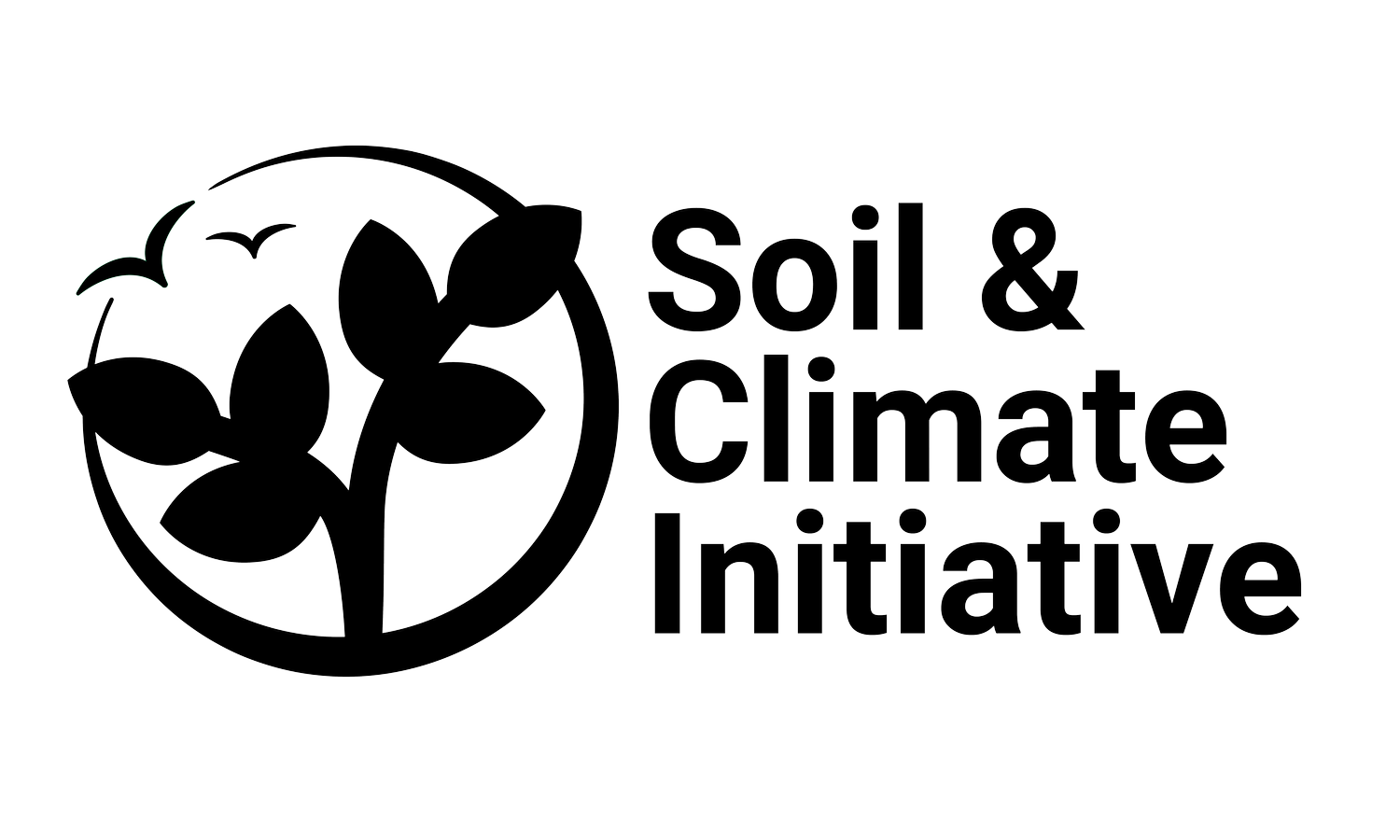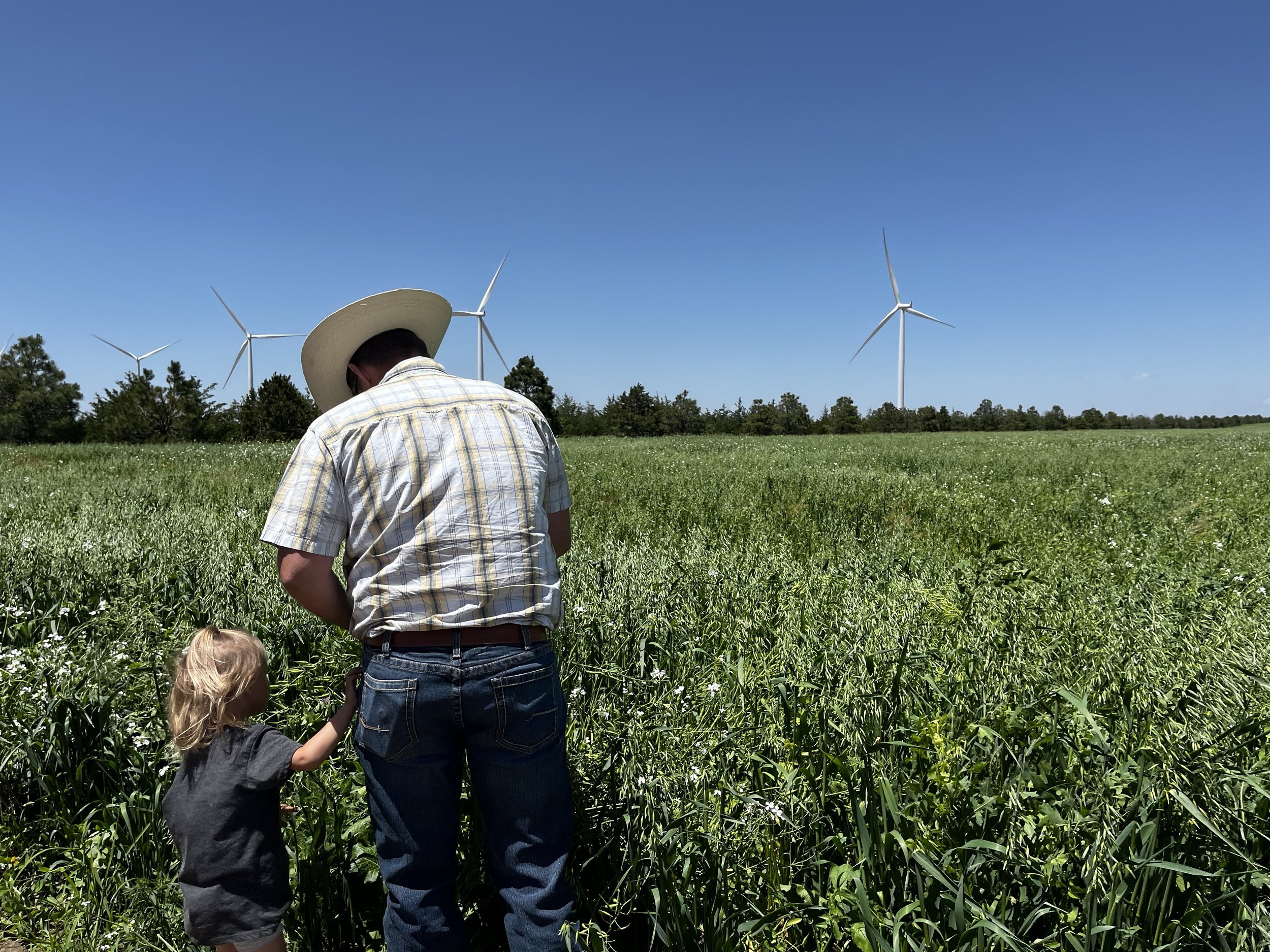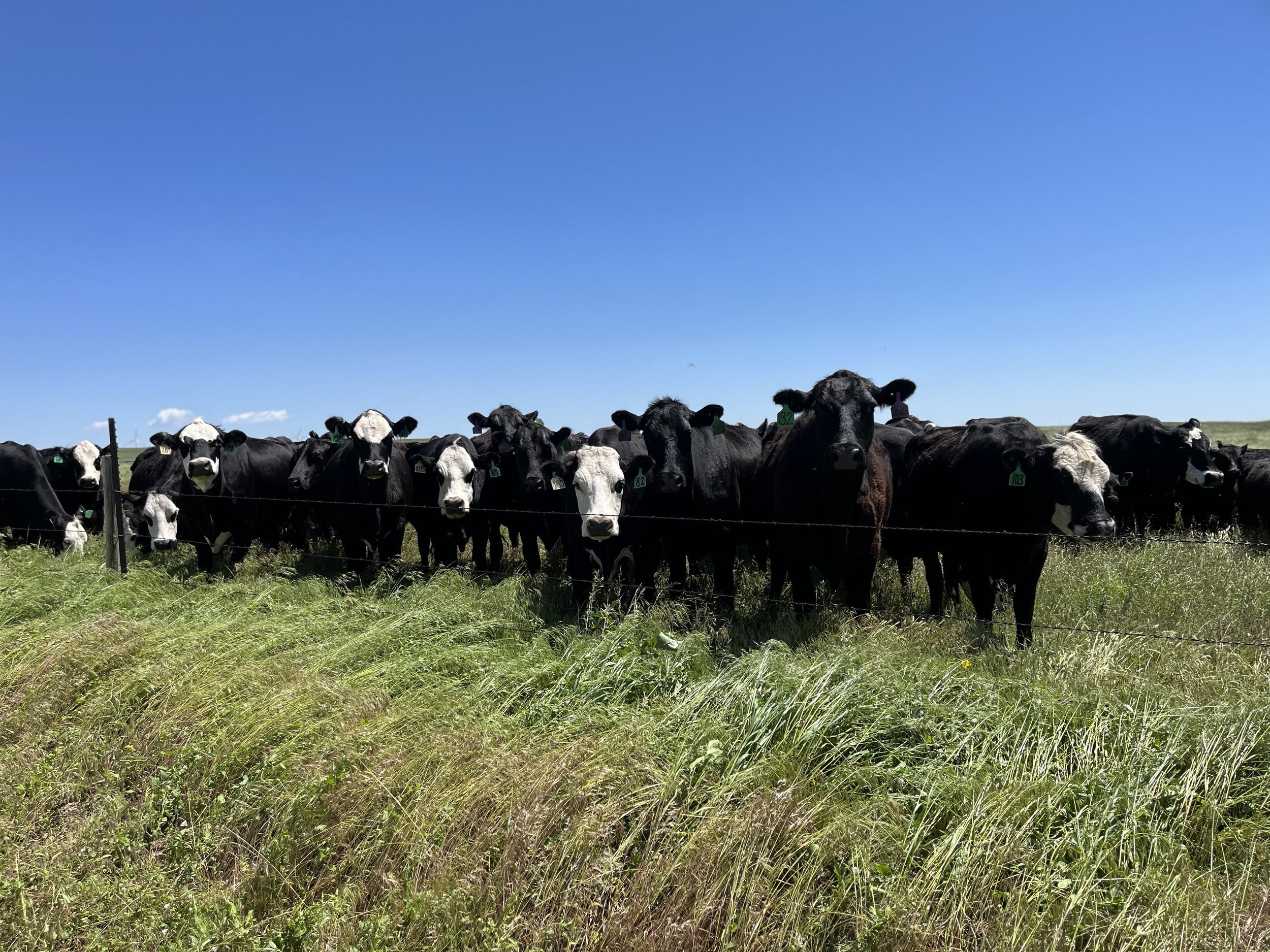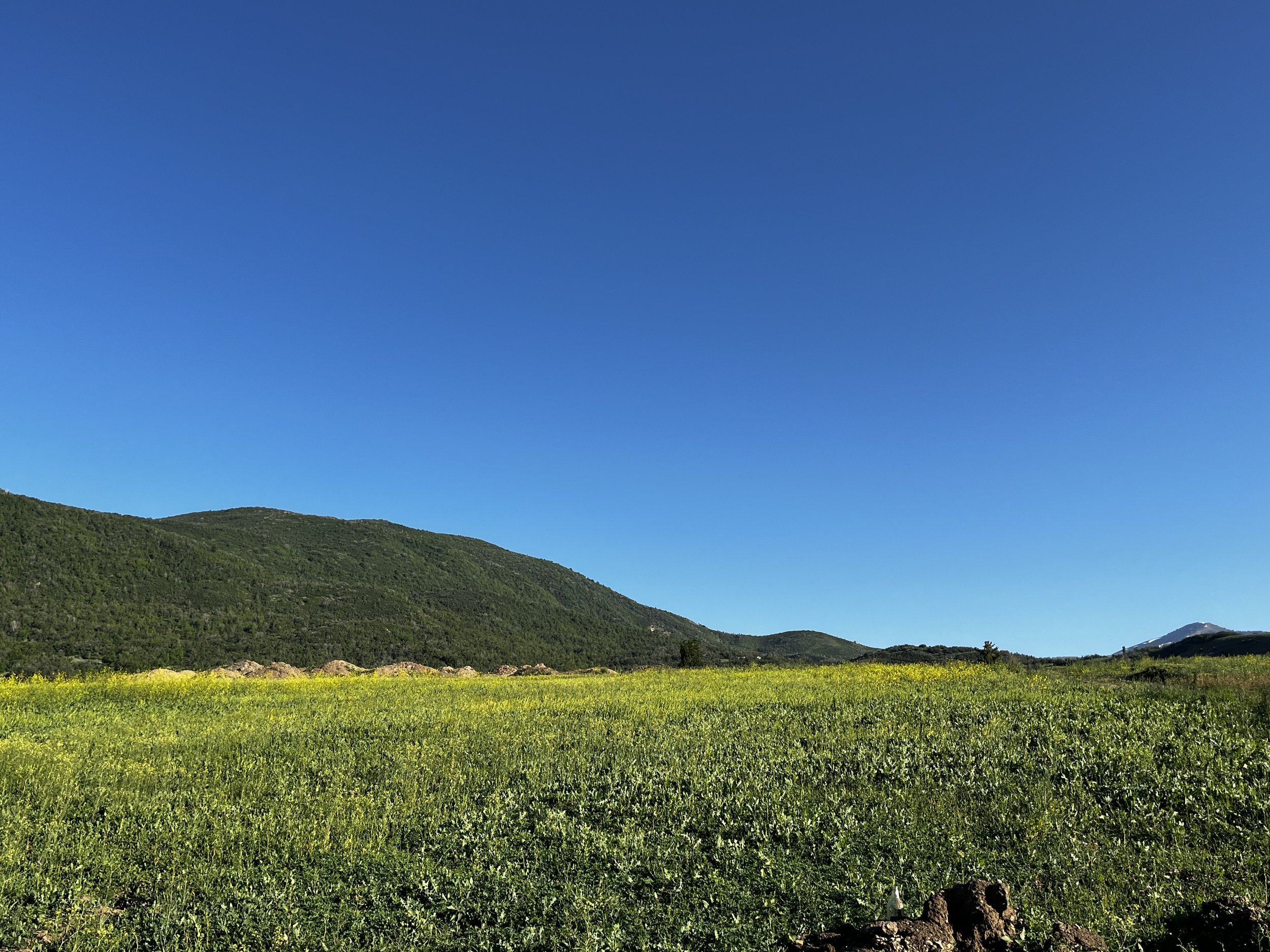Sowing the Seeds of Success:
Soil & Climate Initiative Links Farms to Vital Transition Funding
By Julie Davenson, Farm Finance Specialist
In November, Soil & Climate Initiative (SCI) farmer Levi Kokes received the good news he was awarded $20,000 through Zero FoodPrint’s Restore Grant. The timing of this grant is critical and will allow him to install a new virtual fencing system called Vence at the start of the 2024 grazing system and unlock other sources of capital through Kateri’s programs.
“The benefits to our farm are numerous...I’m excited and energized to be farming and ranching again and to be part of a group that helps me to focus and feed that energy.”
Kokes established and operates Kokes Ranch with his wife and young daughter on an 8300-acre ranch in Crook, CO. The ranch, spanning 7100 acres for grazing and 1200 acres for crop cultivation (including forage, corn, milo, sorghum sudan, millet, and wheat), is a multifaceted operation. Over the past decade, Levi has dedicated efforts to transition his rangeland to regenerative agriculture while planning the succession of the farm to his ownership from his father and uncle.
Levi's primary objective is to produce high-quality, nutrient-dense food for human and animal consumption, marketing it directly to consumers, retail outlets, and wholesale markets. The ranch specializes in raising commercial Akaushi cross cattle and a fullblood registered herd known for their low maintenance and high performance on grass and forage. He plans to extend the enterprise as the herd grows to include breeding stock sales, with the current herd comprising 90 cow/calf pairs raised on grass and forage. To support his ranch’s transition, Levi participated in the FARMS program through Colorado Conservation Tillage Association, focusing on reducing synthetic inputs, minimizing fertilizer use, and incorporating more cover crops and biological inputs such as compost extracts.
Navigating the financial challenges of taking over a farming business while implementing regenerative practices is a complex task. He is not alone in this trend as many farms are in the process of farm succession while simultaneously transitioning regenerative management systems. Operating margins are tight and taking on additional debt is often not a viable option for farmers. Levi has demonstrated resourcefulness by engaging with various programs and resources, including NRCS (Natural Resources Conservation Service) programs and he is also an SCI founding farmer.
SCI is a commitment and verification program providing a farm to market solutions for soil and climate health. It is open to farmers in all production systems. In September, SCI introduced a new service to assist farmers with transition costs, hiring Julie Davenson as their Farm Finance Specialist. This role is responsible for gathering and disseminating funding resources to farmers. This new initiative underscores the commitment to supporting farmers in adopting sustainable and regenerative practices.
Levi is following the Savory Institute’s Holistic Management Framework to manage and plan regenerative grazing on his ranch. In Holistic Planned Grazing, or multi-paddock adaptive grazing, ranchers strategically move cattle to maximize animal impact while ensuring sufficient recovery time for associated benefits. However, implementing more time-intensive grazing practices and restrictions of physical fencing can limit grazing options.
To address this challenge, Levi explored the use of Vence, an innovative virtual fencing technology for livestock management. Vence assists the rancher to control cattle movements, manage grazing, establish virtual fencing to influence grazing behavior, and monitors animal location and movement. The system's benefits include increased forage production, improved grazing land health, and environmental benefits. Additionally, ranchers can conveniently monitor cattle's location and movement through a mobile app.
While the initial setup cost is high, the benefits, including increased forage production, improved grazing land health, and real-time monitoring through a mobile app, make it a promising investment. The challenge lies in securing funds for such technology amid start-up costs and can be prohibitive. Although the USDA’s National Resource Conservation Services (NRCS) offers various cost-share grants for conservation practices, there are limited options of unrestricted grant funding for equipment from federal or private foundations, a significant gap in financing the transition.
Working with the Farm Finance Specialist helped Levi secure the critical funds enabling this project to be viable and move forward. The benefits will be reaped by Levi’s family in saving labor and improving efficiency, improving animal welfare and ecosystems process and functions on his ranch due to the precision in grazing management enabled by this equipment purchase. Levi states, “The virtual fence technology will allow us to graze our rangeland in a way that mimics natural processes and is far more effective at improving soil health.”
In the search for funding, Levi encountered few viable options. Most grants available were under the $5000 range or too restrictive in their uses to fit his needs. He needed a larger source of unrestricted grant funding that allowed him to unlock and blend other sources of financial support to make the investment in the Vence system financially feasible. In searching for funding to help Levi purchase virtual fencing, Julie referred Levi to Zero Food Print's Restore Farm Grants program. In October Julie supported Levi in the grant submission process. Levi explains that without this grant, this innovative technology “would normally be out of our budget.” He said incorporating regenerative grazing would be “both financially and logistically difficult for a ranch our size and with a limited labor force. The savings in fence material and labor can now be put towards other enterprises with the goal of improving our land.”
Zero Foodprint (ZFP), a non-profit organization, is spearheading a movement within the food industry to champion agricultural climate solutions. The organization was established to provide essential support for farmers and ranchers committed to leveraging their land for climate change mitigation but who face financial barriers in adopting regenerative farming practices. Zero Food Print generates funds through partnerships with participating restaurants and retailers, encouraging consumers to contribute 1% of every purchase towards advancing regenerative farming.
Through its Restore Farm Grants program, presently accessible in specific states, including Colorado, ZFP aims to cover approved practices that foster healthy soil. Funds are equitably distributed through a grant process, and trusted local conservation experts estimate the climate benefits while verifying carbon farming projects. As the funds are unrestricted, they can be utilized for matching cost shares, acquiring equipment, or enhancing on-farm infrastructure.
“...I’m excited and energized to be farming and ranching again and to be part of a group that helps me to focus and feed that energy. SCI is a great group and I’m just glad I can be a part of it.” ”
As for SCI, Levi cites the benefits of being a farmer in SCI’s program are numerous including an expanded support network and sharing knowledge with and among other farmers and consultants. Levi shares, “The benefits to our farm are numerous, I already have made great contacts with other members and staff as well as having the ability to share and receive knowledge and experiences that will help me move our farm into a more productive and sustainable future and be happy and fulfilled while doing it. I'm excited and energized to be farming and ranching again and to be part of a group that helps me to focus and feed that energy. SCI is a great group and I'm just glad I can be a part of it.”



